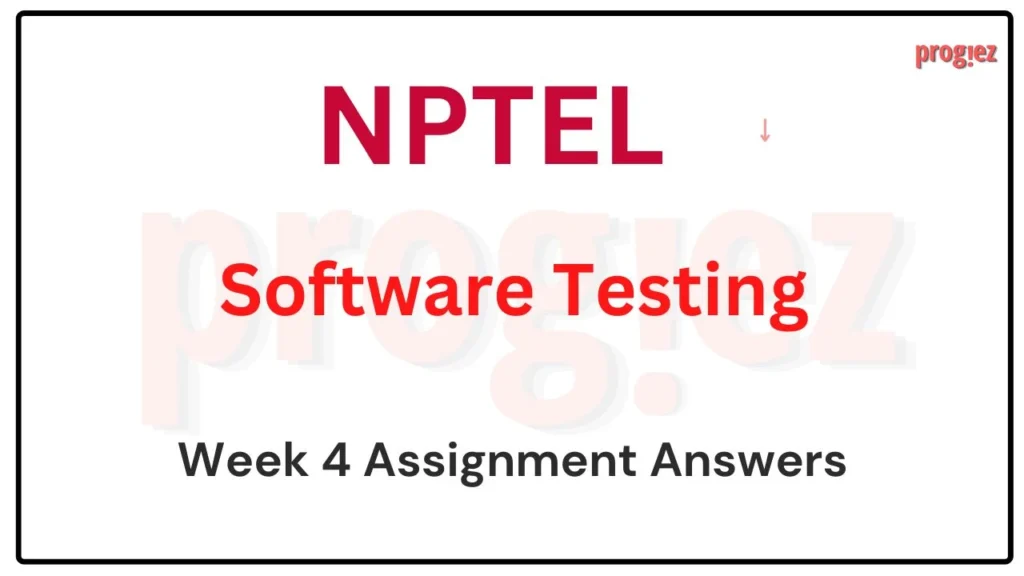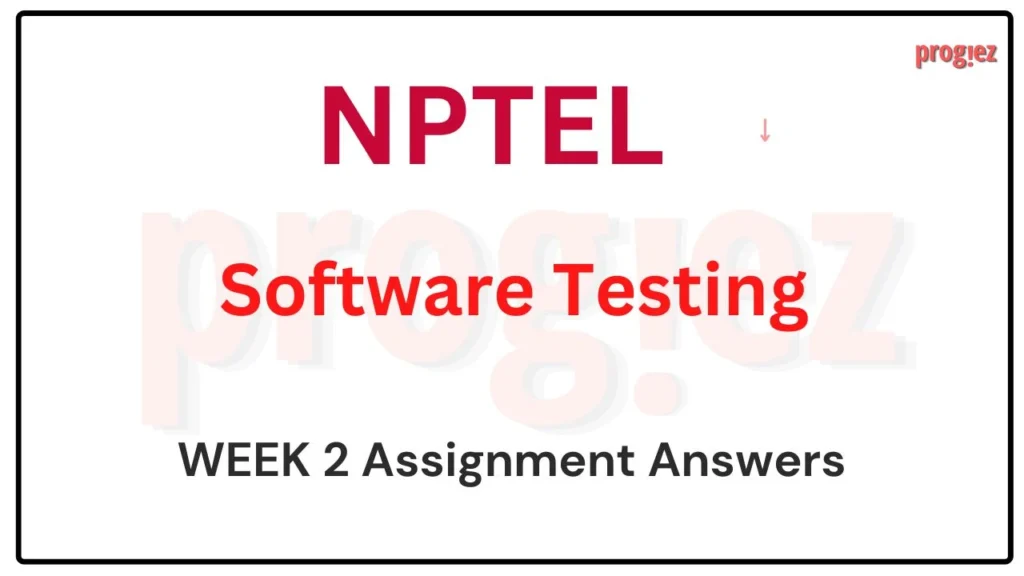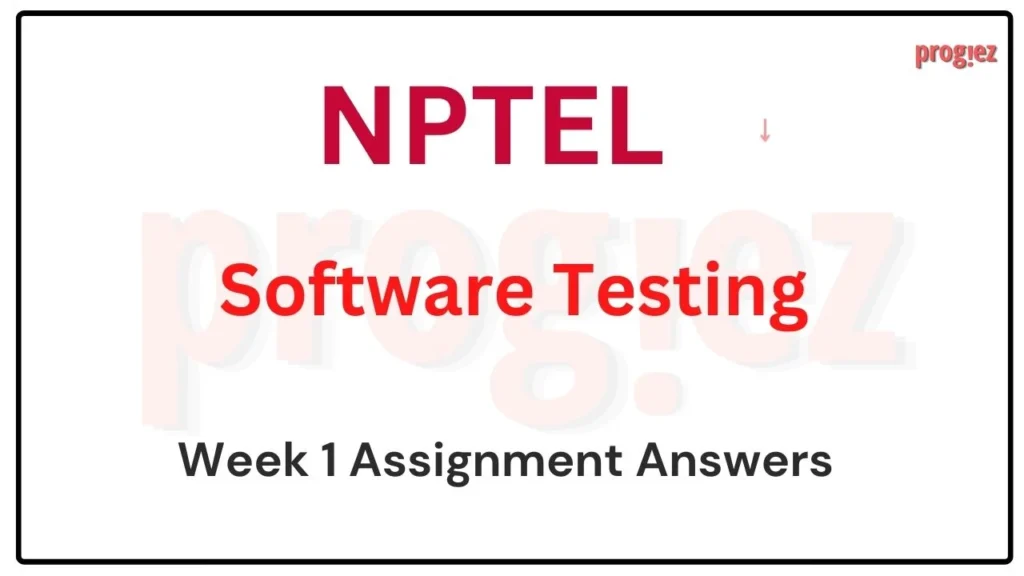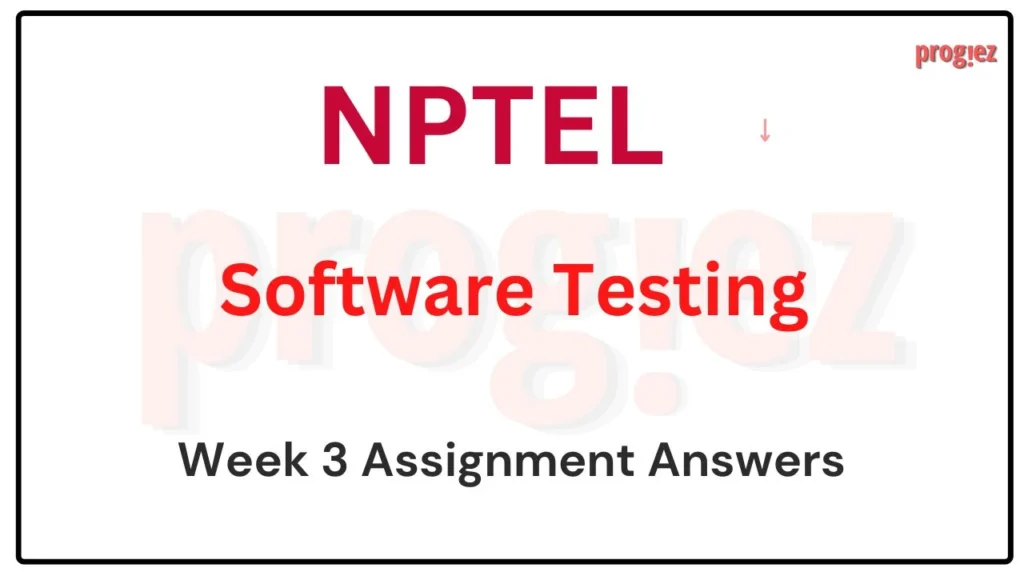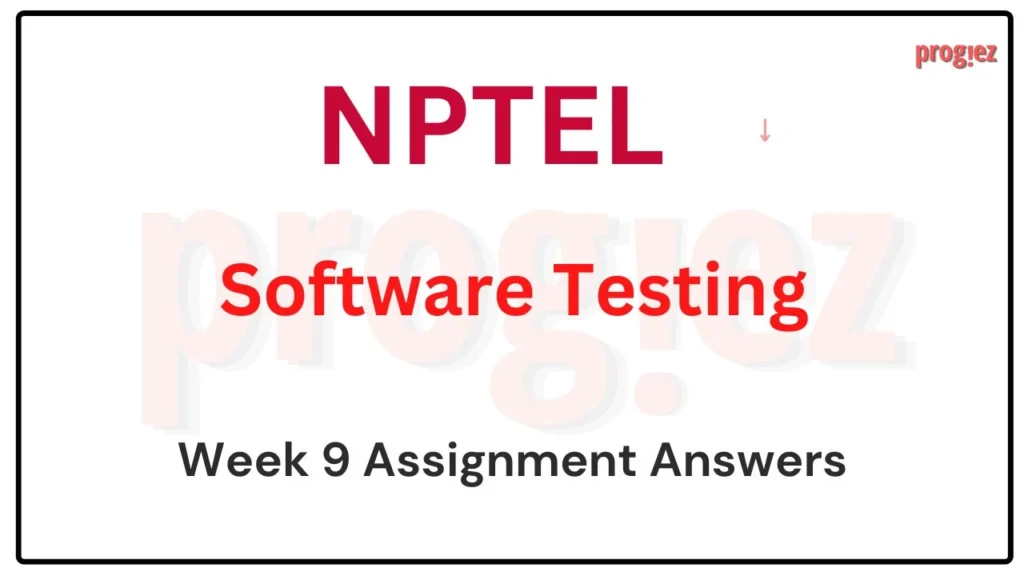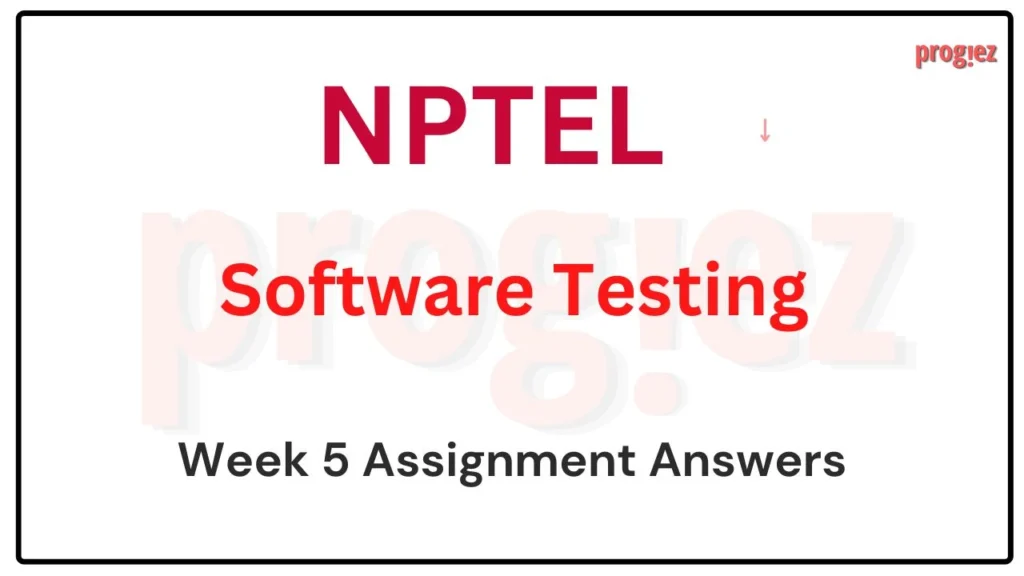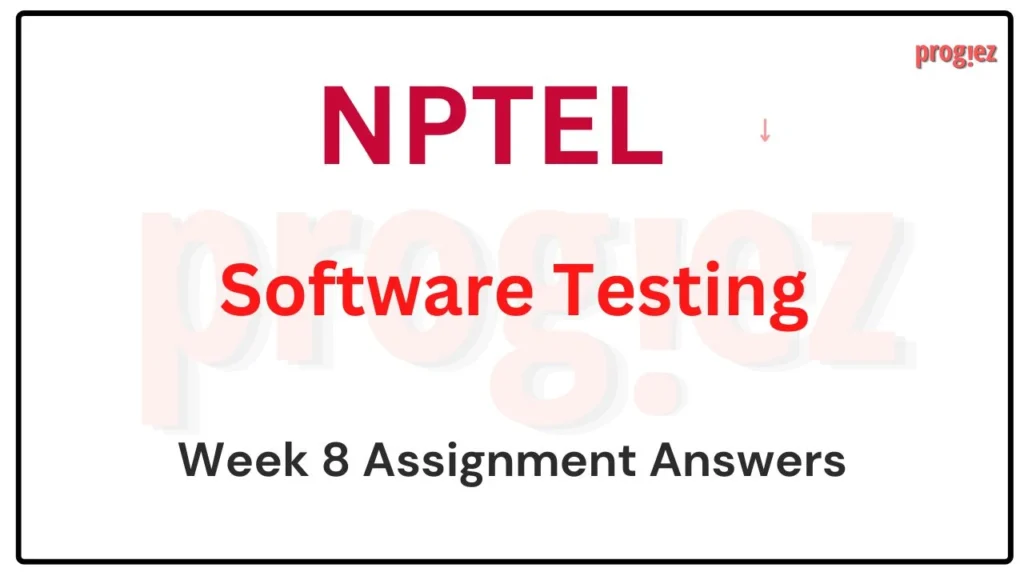Software Testing | Week 1
Session: JAN-APR 2024
Course name: Software Testing
Course Link: Click Here
For answers or latest updates join our telegram channel: Click here to join
These are NPTEL Software Testing Week 1 Assignment 1 Answers
Q1. Pick the correct statement from the following:
a. Every programming error causes a bug
b. Every programming error is caused by a failure
c. Every failure is caused by a fault
d. Every bug can be tracked to a programming error
e. Every bug causes a failure
Answer: c. Every failure is caused by a fault
Q2. The main purpose of integration testing is to find which one of the following types of errors?
a. Logic errors
b. algorithm errors
c. Arithmetic errors
d. Design errors
e. Module interfacing errors
Answer: e. Module interfacing errors
Q3. Which of the following are performance test cases for a Library automation software?
a. Measuring the response time of book issue
b. Checking whether a book is correctly removed from the list of borrowed books of a member after return of the book
c. Checking how easy the system is to use by a member
d. Checking if after the details of a procured book is entered, it is corrected added to the book list
e. Checking whether a member can issue out a reserved book
Answer: a, c
For answers or latest updates join our telegram channel: Click here to join
These are NPTEL Software Testing Week 1 Assignment 1 Answers
Q4. Usability issues are tested during which one of the following type of testing?
a. Unit testing
b. Integration testing
c. Performance testing
d. Regression testing
e. Smoke testing
Answer: c. Performance testing
Q5. The purpose of the error seeding technique is which of the following?
a. Determine the origin of the bugs
b. Plant trojans in code
c. Determine the number of latent bugs
d. Plant insidious bugs before delivery to the customer
e. Introduce known bugs in code to determine whether testing is adequate
Answer: c. Determine the number of latent bugs
e. Introduce known bugs in code to determine whether testing is adequate
Q6. Which of the following are false concerning verification?
a. Helps answer the question: “Have you built the right thing?”
b. Concerns checking the final product against its specification.
c. Usually carried out by the test team.
d. May consist of review and simulation activities
e. Checks whether an artifact produced at the end of a phase conforms to the corresponding artifact produced in a previous phase.
Answer: a. Helps answer the question: “Have you built the right thing?”
b. Concerns checking the final product against its specification.
c. Usually carried out by the test team.
For answers or latest updates join our telegram channel: Click here to join
These are NPTEL Software Testing Week 1 Assignment 1 Answers
Q7. Who among the following performs acceptance testing?
a. Customer
b. Quality assurance team of the developing organization
c. Developers
d. System analysts
e. Test team of the developing organization
f. Independent third party testers
Answer: a. Customer
Q8. Which one of the following testing techniques would be effective for testing whether a developed software meets its non-functional requirements?
a. Path testing
b. Dataflow testing
c. Performance testing
d. Robust boundary-value testing
e. Smoke testing
Answer: c. Performance testing
Q9. Unit testing of a software module does NOT test which of the following?
a. Whether the module interfaces well with other modules.
b. Whether the functions in the module are working as per design.
c. Whether all arithmetic statements in the module are working properly.
d. Whether the module meets the non-functional requirements specified in the SRS document
e. Whether all control statements in the module are working properly.
Answer: a. Whether the module interfaces well with other modules.
d. Whether the module meets the non-functional requirements specified in the SRS document
For answers or latest updates join our telegram channel: Click here to join
These are NPTEL Software Testing Week 1 Assignment 1 Answers
Q10. Suppose an untested program was determined to contain 1280 bugs. Three different testing techniques were applied to test the code. Each testing technique is effective to detect 50% of the bugs that exist before the concerned testing technique is applied. After each testing strategy is applied a bug fix cycle is carried out. While fixing a bug, there is a 50% chance of creating another bug. How many bugs would exist in the code after the three testing and bug-fix cycles have been carried out?
a. 400
b. 540
c. 760
d. 840
e. 1024
Answer: b. 540
For answers or latest updates join our telegram channel: Click here to join
These are NPTEL Software Testing Week 1 Assignment 1 Answers
More Weeks of Software Testing: Click here
More Nptel Courses: https://progiez.com/nptel-assignment-answers
Course Name: Software Testing
Course Link: Click Here
These are NPTEL Software Testing Week 1 Assignment 1 Answers
Q1) The purpose of the error seeding technique is which of the following?
a. Determine the origin of the bugs
b. Plant trojans in code
c. Determine the number of latent bugs
d. Plant insidious bugs before delivery to the customer
e. Introduce known bugs in code to determine whether testing is adequate
Answer: c, e
Q2) The main purpose of integration testing is to find which one of the following types of errors?
a. Logic errors
b. algorithm errors
c. Arithmetic errors
d. Design errors
e. Module interfacing errors
Answer: e. Module interfacing errors
These are NPTEL Software Testing Week 1 Assignment 1 Answers
Q3) Usability issues are tested during which one of the following type of testing?
a. Unit testing
b. Integration testing
c. Performance testing
d. Regression testing
e. Smoke testing
Answer: c. Performance testing
Q4) Pick the correct statement from the following :
a. Every programming error causes a bug
b. Every programming error is caused by a failure
c. Every failure is caused by a fault
d. Every bug can be tracked to a programming error
e. Every bug causes a failure
Answer: c. Every failure is caused by a fault
These are NPTEL Software Testing Week 1 Assignment 1 Answers
Q5) Which one of the following is false concerning verification?
a. Helps answer the question : “Have you built the right thing?”
b. Concerns checking the final product against its specification.
c. Usually carried out by the test team.
d. May consist of review and simulation activities
e. Checks whether an artifact produced at the end of a phase conforms to the corresponding artifact produced in a previous phase.
Answer: a, b, c
Q6) Who among the following performs acceptance testing?
a. Customer
b. Quality assurance team of the developing organization
c. Developers
d. System analysts
e. Test team of the developing organization
Answer: a. Customer
These are NPTEL Software Testing Week 1 Assignment 1 Answers
Q7) Which one of the following testing technique is effective for testing whether a developed software meets its non-functional requirements?
a. Path testing
b. Dataflow testing
c. Performance testing
d. Robust boundary-value testing
e. Smoke testing
Answer: c. Performance testing
Q8) Unit testing of a software module does NOT test which of the following?
a. Whether the module interfaces well with other modules.
b. Whether the functions in the module are working as per design.
c. Whether all arithmetic statements in the module are working properly.
d. Whether the module meets the non-functional requirements specified in the SRS document
e. Whether all control statements in the module are working properly.
Answer: a, d
These are NPTEL Software Testing Week 1 Assignment 1 Answers
Q9) Which one of the following can be inferred from the pesticide paradox?
a. Greater number of bugs are detected towards the end of a testing process
b. More severe bugs are detected towards the end of a testing process
c. After a test methodology has been used on a program to detect bugs, it is ineffective for detecting the remaining bugs
d. A test methodology should be applied again and again until all the bugs have been eliminated
e. A good testing methodology when used several times on a program, effectively expose almost all bugs latent in it
Answer: c. After a test methodology has been used on a program to detect bugs, it is ineffective for detecting the remaining bugs
Q10) The V model of software development is not appropriate for the development of which of the following applications?
a. Nuclear reactor control software
b. Avionics software
c. Automotive control software
d. Management information system (MIS) software
e. Graphical user interface development project
Answer: d, e
These are NPTEL Software Testing Week 1 Assignment 1 Answers
1. Choose the right option to fill in the blank: Suppose a method M1M1 calls a method M2M2, which in turn, calls another method M3M3. The level of testing that tests for the interface of calls from M1M1 to M2M2 and then to M3M3 is called as . . . . . . . . . . . ..
a. Functional testing.
b. Unit testing.
c. Integration testing.
d. System testing.
Answer:- c
2. State true or false: A coverage criterion C1 said to subsume another coverage criterion C2 if there is at least one test case that satisfies C1 which also satisfies C2.
a. True.
b. False.
Answer:- b
These are NPTEL Software Testing Week 1 Assignment 1 Answers
3. State true or false: Testing can be used to find all the errors in code.
a. True.
b. False.
Answer:- a
These are NPTEL Software Testing Week 1 Assignment 1 Answers
4. Which of the following are practised in level 3 thinking during testing?
a. Testing is a mental discipline, everyone in an organization strives to test thoroughly.
b. Testing is done mainly by developers, to debug their code.
c. Testing is done to identify failures and reduce risks.
d. Testing is done to show absence of errors.
Answer:- c
These are NPTEL Software Testing Week 1 Assignment 1 Answers
5. Which of the following best defines usability testing?
a. Testing done to ensure that the software looks nice.
b. Testing done to ensure that the software is usable by all the users.
c. Testing done to understand how users can use a software.”
d. Testing done to ensure that the user interface of the software is as specified in the requirements
Answer:- d
6. Which of the following is a list of white-box testing techniques?
Answer:- c
These are NPTEL Software Testing Week 1 Assignment 1 Answers
7. As per the lectures, which of the following sentences best defines a test case?
a. A test case contains only inputs to the software artifact.
b. A test case contains inputs to the software artifact along with the expected outputs
c. A test case contains inputs to the software artifact and a decision on pass or fail.
d. A test case contains inputs to the software artifact, which is run and the actual output is also recorded as a part o f the test case.
Answer:- b
These are NPTEL Software Testing Week 1 Assignment 1 Answers
8. When do we say that a set of test cases T satisfies the test requirements TR for a coverage criterion C?
a. For every test requirement tr ∈ TR, there is exactly one test case t ∈ T such that t satisfies tr.
b. For some test requirement tr ∈ TR, there is some test case tt such that t∈T such that t satisfies tr.
c. For some test requirement tr∈TR, all the test cases t∈T are such that tt satisfies tr.
d. For every test requirement tr ∈ TR, there is at least one test case t ∈ T such that t satisfies tr.
Answer:- d
These are NPTEL Software Testing Week 1 Assignment 1 Answers
9. When do we say that a coverage criterion C1 subsumes a coverage criterion C2?
Answer:- b
These are NPTEL Software Testing Week 1 Assignment 1 Answers
10. What does the JUnit assertion assertFalse(val1 > val2) return whenval1 is less than val2?
a. True.
b. False.
Answer:- b
These are NPTEL Software Testing Week 1 Assignment 1 Answers
More Weeks of Software Testing: Click here

